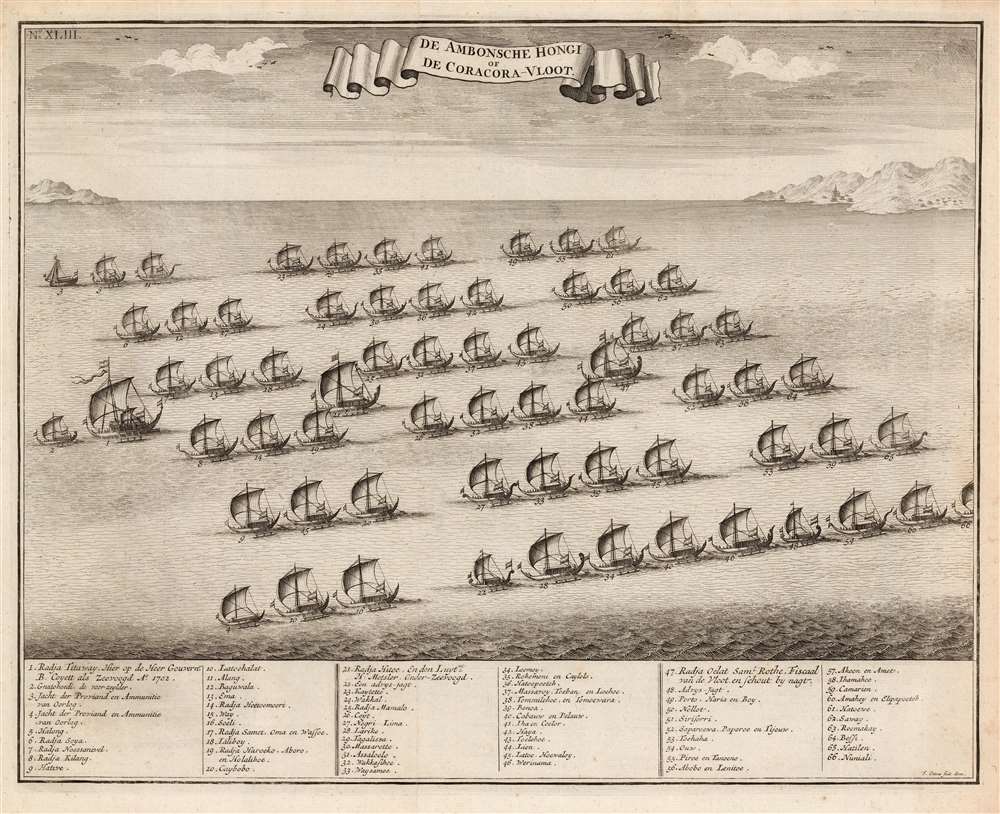This item has been sold, but you can get on the Waitlist to be notified if another example becomes available, or purchase a digital scan.
1724 Valentijn view of the Ambon Fleet, Enforcing the Dutch Spice Monopoly
AmbonFleet-valentijn-1724
Title
1724 (undated) 12 x 15.25 in (30.48 x 38.735 cm)
Description
The View in Detail
Each kora-kora is named in the numbered table below the view. The Governor's kora-kora, and those of the leading Rajahs, are prominently noted. The Hongitochten were force-backed VOC inspections of the spice-producing parts of the Moluccas intended to enforce the VOC's monopoly over the trade in cloves - which grew almost exclusively in the Moluccas.Hongitochten
The Dutch practice of hongitochten began in the 17th century and continued until the spice monopoly ended in 1824. The Moluccas covered a large region where a full naval cordon was impractical. The VOC instead concentrated production on the islands where it had control - systematically destroying trees on other islands, compensating local princes with an annual bounty. The VOC adopted hongi (traditional war fleets of kora-kora) to enforce their monopoly. Originally a feature of inter-island warfare, the hongi were made up of native ships and troops, accompanied by the governor and a contingent of VOC soldiers. They were ostensibly an enforcer of gubernatorial authority, but their main purpose was to suppress spice competition. During patrols, illegal clove plantations and caches were sought out and destroyed. The Dutch actively took advantage of tribal and inter-island enmities to both discover illegal cloves and enforce punishment. Generous bounties were offered for smugglers, ideally taken alive. In spite of this, many were killed and displayed at bow and stern of the capturing kora-kora.Publication History and Census
This engraving was cut by Frederik Ottens for the second volume of François Valentijn's Oud en nieuw Oost-Indiën, printed in 1724. There are no separate examples of this print cataloged in OCLC, although the book is well represented in institutional collections.CartographerS
Francois Valentijn (April 17, 1666 - August 6, 1727) was a Dutch minister, naturalist, colonial administrator, and historian active in Holland and the East Indies, in the late 17th and early 18th centuries. Valentijn was born in Dordrecht, Holland and studied at the Universities and Leiden and Utrecht before, in 1685, taking a position with the Dutch East India Company (VOC). He remained in the East Indies for about 10 years before returning to Dordrecht. Unable to adjust to life in Europe, he returned to the East Indies in 1705 where he remained for another 9 years. After 19 total years in the Orient working for the VOC, Valentijn once again returned to Holland where he composed his eight volume five part masterwork Oud en Nieuw Oost-Indien. The scope and detail of this work, including over 1000 engraved images and numerous maps was unprecedented with regards to Asia. The work contained some of the finest and most detailed large scale maps of the East Indies ever published. The most important of these focus on Taiwan and Malaya. Valentijn most likely drew on secret VOC manuscript maps and documents, a fact that makes it exceptionally surprising that his works were actually published. Valentijn academic scholarship, in sharp contrast to his cartographic work, is often highly criticized as being self-aggrandizing and, more often than not, plagiarized. More by this mapmaker...
Frederik Ottens (fl. 1717 - 1770) was a Dutch printmaker and draughtsman. One of the sons of Joachim Ottens (1663 - 1719), as well as his student, he would not take control of the firm. This passed to Joachim's elder sons Renier (1698 - 1750) and Joshua (1698 - 1750). The firm were prominent Dutch booksellers and map publishers from about 1680 to 1785. During the prolific period under Renier and Joshua's aegis, Frederik executed many of the family's illustrations. He also worked for other printers. His engravings also appeared in François Valentijn's 1724 Oud en nieuw Oost-Indiën. Learn More...

